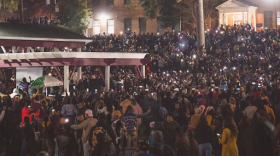-
After Tropical Storm Chantal, community members are skeptical of the Town of Chapel Hill’s plans to manage stormwater requirements for new developments.
-
Chapel Hill's Shake Shack latest business to reopen after Chantal, partners with hunger relief groupThe restaurant opened ahead of schedule, after it took on a lot of damage due to the storm.
-
A community member proposed a Charlie Kirk mural to honor the slain conservative activist. It also sparked a counter-petition.
-
The USDA gave a North Carolina organization more than $292,000 in grant funding to expand its mental health services for farm communities devastated by Helene.
-
North Carolina federal employees and others across the nation aren’t getting paid, leaving them to lean on their communities for basic necessities like food.
-
Historically Black Colleges and Universities nationwide have seen a recent increase in violent incidents during homecoming celebrations. In response, several North Carolina HBCUs are implementing new safety measures.
-
Many gathered at Pride: Durham, NC events last weekend to celebrate the LGBTQ+ community through a parade, musical performances, a resource fair and other festivities.
-
Union Grove Farms is pursuing “agritourism” expansions despite an initial rejection from the Orange County Planning Board.
-
The online bookstore is run entirely by the volunteers at Friends of the Durham Library, a nonprofit that has worked with the library since at least the 1980s, Shayne Goodrum, FODL's former president, said.
-
The aid-on-wheels program, which began this past January, served 3,000 individuals in its first 70 days, illustrating the "urgent need," the organization said in a statement, for solutions that bring resources directly to those they serve.
Play Live Radio
Next Up:
0:00
0:00
Available On Air Stations










